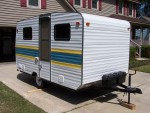What size roof joists?
15 posts
• Page 1 of 1
What size roof joists?
I used 1X2's on 12" centers for the roof on my weekender build on a 5X8 NT trailer (60" roof span). With 1/4" ply skins that seemed to be plenty sturdy. On my new "pop-up to retro" project, I will have an 80" roof span (out to out). Does anyone have any experience building this wide? Will 1X2's be adequate or do I need to move up to 1X3?
-

les45 - 500 Club
- Posts: 974
- Images: 605
- Joined: Sat Feb 25, 2012 8:57 am
- Location: Aiken, South Carolina
Re: What size roof joists?
As long as your standing them up long ways they will work just fine. Double stack 3/4" blue or pink folks the gaps perfectly for insulation.
Sent from my Pixel 2 XL using Tapatalk
Sent from my Pixel 2 XL using Tapatalk
Steve
[email protected]
[email protected]
-

linuxmanxxx - 500 Club
- Posts: 802
- Images: 10
- Joined: Fri Sep 10, 2010 1:50 am
- Location: Abilene TX

